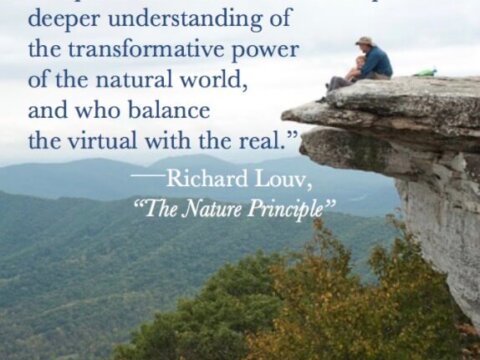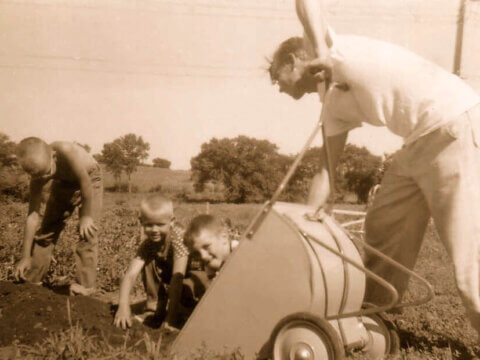VITAMIN N FOR THE SOUL: How Nature Can Nourish the Spirit of Children and Adults
Matthew, my youngest son, once asked me if a connection to a higher power is, in fact, an underutilized sense—one that some people find activated in nature. This is the same son who, when he was five, asked, “Are God and Mother Nature married, or just good friends?”
Great questions. Most religious traditions, especially in indigenous cultures, intimately or actively offer ways to discover the divine in the natural world. Some people worship nature. Others consider such worship blasphemous, or detect nothing. Most of us are less direct. Just beyond the veil of rain, we sense a presence for which we have no name.
Since the publication of “Last Child in the Woods” in 2005, I’ve been surprised and impressed by the support that many religious leaders of all faiths, and nonbelievers as well— and from very different political persuasions—have offered to the growing movement to connect people, especially children, to the natural world. One of the first and unexpected champions of the book was the Rev. Albert Mohler, Jr., a conservative radio host and president of the Southern Baptist Theological Seminary, who wrote: “Christians should take the lead in reconnecting with nature and disconnecting from machines.” When I was asked to be on The 700 Club, Pat Robertson’s show on the Christian Broadcasting Network, a friend (who worked for a large environmental organization) said, “Don’t go, it’s a trap.” The segment, including footage of children outdoors, turned out to be very good. Other religious voices chimed in—Presbyterians, Buddhists, Muslims, Unitarians, Jews.
In a provocative piece for the Torah Aura Productions Bulletin Board, titled “It is not Jewish to Stay Inside,” Idie Benjamin and Dale Cooperman wrote, “At the Seder, we eat green vegetables to remind us of spring. We celebrate the holiday of Sukkot by sitting outside in our sukkot for eight days, surrounded by the fruits of the harvest. Is it any wonder that the holiday is called zman simhatainu, the time of our happiness?” They pointed out that, “Tu B’Shvat has become a Jewish Earth Day, a time to focus on the earth that God gave us and how better to care for our world.

But in many classrooms, that caring and learning are too often happening inside with paper trees and pink tissue paper blossoms. We even know of schools where there is no interaction with a real tree while the children ‘learn’ about Tu B’Shvat.” Benjamin and Cooperman challenged their readers to do more to connect children, and themselves, to nature: “Tu B’Shvat as our annual reminder that we need to be outside and not just outside on our playgrounds. We need to be bringing children to nature and nature to children.”
Perhaps I should not have been surprised by the reaction. Smart spiritual people intuitively understand that all spiritual life begins with a sense of wonder, and that sense is usually formed early in childhood, often in natural settings.
There is, in fact, something about this issue that brings people together. This caring comes partly because so many of us recall our special places in nature, where we were so often alone with our thoughts, so tuned to our senses.
Our affiliation with the natural world, as the Harvard entomologist, E. O. Wilson suggests, is in our genes. It’s part of who we are, and it never quite goes away. While Wilson’s biophilia hypothesis is based on our biology as a species, I believe that the hunger is also spiritual. Many others do, too. Including people who would not describe themselves as religious.
In 1995, the MIT Press published the results of one of the most extensive surveys of how Americans really think about environmental issues. The researchers were stunned by what they discovered. They noted an increased environmental consciousness observed in language (for example, a patch of land once referred to as a swamp was more likely to be called wetlands). The fact that environmental values were already intertwined with core values of parental responsibility, was, the researchers asserted, “a major finding.” In addition, a substantial majority of people surveyed justified environmental protection by explicitly invoking God as the creator, with striking uniformity across subgroups. “What is going on here? Why should so many nonbelievers argue on the basis of God’s creation?” the researchers asked. “It seems that divine creation is the closest concept American culture provides to express the sacredness of nature. Regardless of whether one actually believes in biblical Creation, it is the best vehicle we have to express this value.”
In other words, for environmentalists, arguing for the protection of a particular toad is, while important, less potent than calling for the protection of God’s creation (which includes the toad).
The point here is not the worship of nature, but the nourishing of the spirit. In an interview with the Catholic News Service, John Lionberger, author of “Renewal in the Wilderness: A Spiritual Guide to Connecting With God in the Natural World”, said he was once an agnostic but experienced a spiritual awakening on a dogsled trip. Children and young people, he said, experience a “sense of spirituality” in wilderness, especially through challenges “that being at home in a contained environment doesn’t give them.”
Animals play a special role in children’s hearts, and many of us retain that sensitivity into adulthood. Recognition of the spiritual quality of this connection will increase as the epidemic of human loneliness grows. This isolation is rooted in a species loneliness.
 In “Our Wild Calling: How Connecting to Animals Can Transform Our Lives,” I suggest: “Each animal we encounter, domesticated or wild, has the potential to become part of us or part of who we could become. If we meet them halfway. The American transcendentalists of the nineteenth century saw the divine in nature. That movement’s leader, Ralph Waldo Emerson, wrote of the ‘great nature in which we rest, as the earth lies in the soft arms of the atmosphere; that Unity, that Over-soul, within which every man’s particular being is contained and made one with all other; that common heart.’” In Shinto, Buddhist, Hindu, and Indigenous cultures bring other and older ways of describing this habitat of the heart. In 2015, at an annual conference of North American wildlife biologists, I met Ovide Mercredi, a Canadian poet and former national chief of the Assembly of First Nations. In his speech, he called for a broader view of the human connection to other animals. “What you call wildlife, we call relatives,” he said to the attendees. He was speaking not only biologically, but spiritually.
In “Our Wild Calling: How Connecting to Animals Can Transform Our Lives,” I suggest: “Each animal we encounter, domesticated or wild, has the potential to become part of us or part of who we could become. If we meet them halfway. The American transcendentalists of the nineteenth century saw the divine in nature. That movement’s leader, Ralph Waldo Emerson, wrote of the ‘great nature in which we rest, as the earth lies in the soft arms of the atmosphere; that Unity, that Over-soul, within which every man’s particular being is contained and made one with all other; that common heart.’” In Shinto, Buddhist, Hindu, and Indigenous cultures bring other and older ways of describing this habitat of the heart. In 2015, at an annual conference of North American wildlife biologists, I met Ovide Mercredi, a Canadian poet and former national chief of the Assembly of First Nations. In his speech, he called for a broader view of the human connection to other animals. “What you call wildlife, we call relatives,” he said to the attendees. He was speaking not only biologically, but spiritually.
A deeper connection to the natural world, best seeded when we are children, can be ignited at any age. Jonathan Stahl, a wilderness educator, feels spiritually connected when experiencing the natural world; that is, as author David Abram puts it, the more-than-human world. “I was brought up Jewish but never really identified with the religion (or any other for that matter),” says Stahl. “I did, however, find my own way of incorporating some of the principles of the holiday Yom Kippur into my life.” Yom Kippur, the Day of Atonement, is a time to pray for forgiveness for sins committed during the year, and to make a clean start for the new year.
On Yom Kipper, Stahl heads for a local trail, preferably one that leads to a high viewpoint. “I find a rock and carry it in my hand, constantly meditating on anything I’ve done in the past year that I am not proud of or would like to improve upon in the following year,” he says. “If ever my thoughts begin to drift, the rock in my hand brings my attention back to the reason for this special hike. I think through various aspects of my life: career, family, friends, relationships, personal wellness, etc., and carry the weight to the top of the mountain. There, I leave the rock and all it represents, and look to the new horizon to start the year fresh. It’s symbolic and not at all traditional to Judaism, but it works for me.” He’s practiced this ritual for several years and has shared his tradition. “It’s a way of bringing nature into religion and at least some aspect of Judaism into my life,” he says.
Thomas Berry would have loved that story. I first met Berry in 2005. He was ninety-one and living in Greensboro, North Carolina. Carolyn Toben, the founder of the nonprofit Center for Education, Imagination, and the Natural World, invited me to lunch with Berry, who founded the History of Religions Program at Fordham University and the Riverdale Center of Religious Research. His books, including The Dream of the Earth, remain influential throughout the world. Berry argued, eloquently and elegantly, that our environmental problems are primarily issues of the spirit. He often spoke and wrote about the transcendent childhood experience that served as a touchstone for his future life and work. “It was an early afternoon in May when I first looked down over the scene and saw the meadow,” he wrote. “A magic moment, this experience gave to my life something, I know not what, that seems to explain my life at a more profound level than almost any other experience I can remember.” That moment never ended.
The great work of the twenty-first century will be to reconnect to the natural world as a source of meaning. Berry articulated a view seldom witnessed in popular media; that we must move beyond the conflict between worlds. In one corner is science, steeped in the “Darwinian principle of natural selection, which involves no psychic or conscious purpose, but is instead a struggle for earthly survival.” This view of reality “represents the universe as a random sequence of physical and biological interactions with no inherent meaning.” In the other corner is the dominant Western religious tradition, which, he said, has moved too far from an older creation story, and toward a redemption mystique, in which passage to the next world is paramount and the natural world is of little concern. Most of the time, these two worlds— science and religion—communicate politely, but the antagonisms are deep. And yet, Berry wrote in “The Great Work,” we are moving into an extraordinary time: “As we enter the twenty-first century, we are experiencing a moment of grace. Such moments are privileged moments.” As he also wrote:
“We need the sun, the moon, the stars, the rivers and the mountains and birds, the fish in the sea, to evoke a world of mystery, to evoke the sacred. It gives us a sense of awe. This is a response to the cosmic liturgy, since the universe itself is a sacred liturgy.”
 We can see the possibility of an expanding movement among faith-oriented environmentalists who are eager to move beyond the old divide between Bible-based interpretations of dominion and stewardship. We can see the possibility in the young people who now dedicate their lives to sustainability, to the climate change movement, to biophilic design. We can see it in the growing recognition that exposure to nature enhances health, improves cognitive functioning, and nurtures the spirit. We can see it among the religious and nonreligious alike.
We can see the possibility of an expanding movement among faith-oriented environmentalists who are eager to move beyond the old divide between Bible-based interpretations of dominion and stewardship. We can see the possibility in the young people who now dedicate their lives to sustainability, to the climate change movement, to biophilic design. We can see it in the growing recognition that exposure to nature enhances health, improves cognitive functioning, and nurtures the spirit. We can see it among the religious and nonreligious alike.
The last time I visited Berry was in 2009, in his room at an assisted-living home, not long before he died. He told me he felt an urgency to “go out into the natural world every day, no matter what the conditions are.” Then he said, “In our later years, we feel a return. To be gifted with delight as a child, the giftedness should continue. The aging process is full of excitement that comes along with the pain of going through the changes. The giftedness continues.”
So does the potential for wonder. We yearn for our other kin. We are not alone on this earth. Many of our pathologies, as a species, come from or are aggravated by our arrogant belief that we can go it alone. In wilderness or in cities, we need nature, and, of course, most of us need other human beings to help us discover nature. For children and adults, a relatively new and rapidly growing body of scientific evidence suggests just how vital our contact with the natural world is for our cognitive development, and for our physical, psychological health. And, though science cannot quantify the soul, our spiritual health is also part of this equation. Perhaps the most important part.
In his book God in Search of Man, Abraham Joshua Heschel, a great Jewish theologian, wrote, “Our goal should be to live life in radical amazement.” Heschel would encourage his students to get up in the morning and look at the world in a way that takes nothing for granted: “Everything is phenomenal; everything is incredible; never treat life casually. To be spiritual is to be amazed.” For many people, organized religion offers the necessary structure, a weekly reminder that there is more to life and afterlife than budgeting and blackness. Others find a different or overlapping source, as indigenous peoples have for millennia.
A movement is growing, one based on the simple idea that the health of our children, and ourselves, and the health of the Earth itself, are intertwined. Now comes the time to move quickly, beyond cultural awareness toward individual and institutional action — including by faith-based organizations.
Those of us who grew up freer in nature have a special responsibility to pass our love of it to our children and grandchildren. We can do that by taking them outdoors with us, and encouraging schools, neighborhoods, and whole cities to become nature-rich. In sermons and in practice, religious leaders can explore the spiritual value of our connection to nature. Religious organizations can increase the availability of nature-based preschools and childcare centers, especially for less affluent children in inner cities. Synagogues, churches, and mosques can organize outdoor activities for families, and not only those of their own congregation. They can work to conserve wilderness, but they can also encourage the seeding of native plants and greater biodiversity on their own properties, in schoolyards, and in surrounding neighborhoods. Religious groups can be powerful advocates for the human right of children to connect to nature—not only the children of parents who already value nature, or of the privileged, or of a specific religion, race, or set of abilities, but all children.
No one wants to belong to the last generation to be touched deeply by the natural world. Each of us can tell our stories, our own and those of our ancestors. And we can listen closely to the children who still sense something larger in the natural world. David J. Wolfe, in “Teaching Your Children About God,” recounts a Hasidic story: “The child of a certain rabbi used to wander in the woods. At first, his father let him wander, but over time he became concerned.” One day, he said to his son, ‘“You know, I have noticed that each day you walk into the woods. I wonder why you go there?’ The boy answered, ‘I go there to find God.’ ‘That is a very good thing,’ the father replied gently. ‘I am glad you are searching for God. But, my child, don’t you know that God is the same everywhere?’ ‘Yes,’ the boy answered, ‘but I’m not.’
-
Network News
Earth Day: Young leaders advocate for change
-
Feature
Nature photographer Dudley Edmondson has a vision for the representation of Black and Brown faces in the outdoors
-
Richard Louv
EARTH MONTH: You're part of the New Nature Movement if....
-
Voices
Placemaking: How to build kinship and inclusive park spaces for children with disabilities
-
Network News
Children & Nature Network founders release report on global factors influencing the children and nature movement








Commentaries on the C&NN website are offered to share diverse points-of-view from the global children and nature movement and to encourage new thinking and debate. The views and opinions expressed are those of the author(s) and do not necessarily reflect the position of C&NN. C&NN does not officially endorse every statement, report or product mentioned.